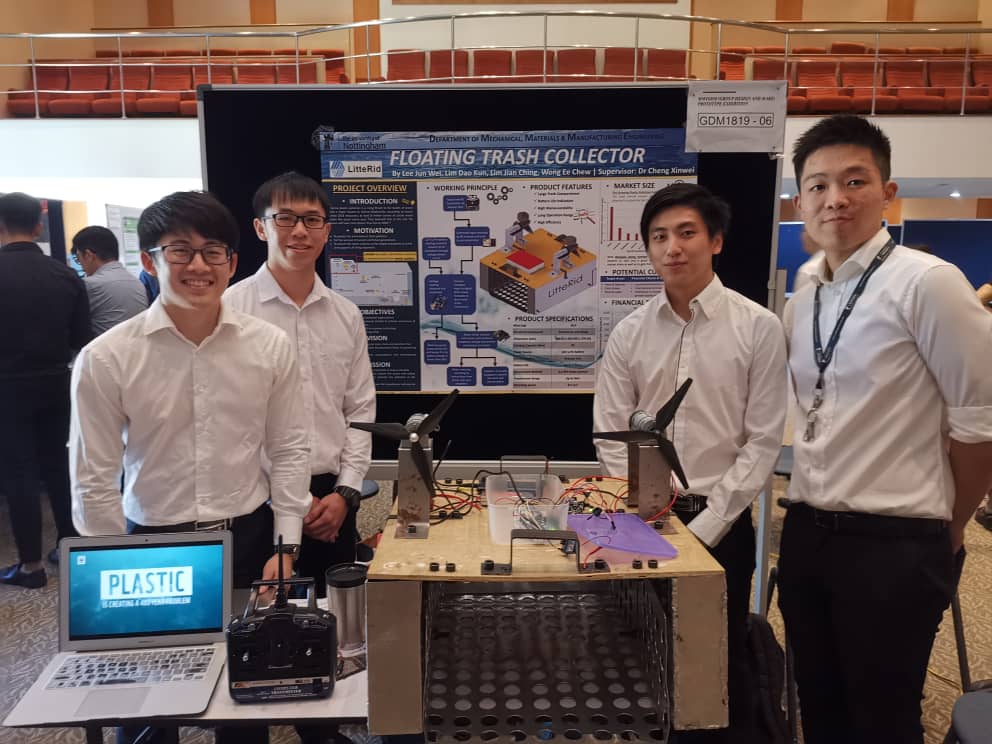What it does
BRING THE OCEAN BACK TO ITS ORIGINAL STATE. By 2050, the ocean will have more plastics than fish. To solve that, our prototype is designed in a way that it is convenient, quick and easy to use. It can move with 0.5m/s and capture 46L of plastic for recycling.
Your inspiration
BRING THE OCEAN BACK TO ITS ORIGINAL STATE. According to Ocean Unite 2018 resources, 8 million tonnes of plastic waste enter the ocean every year. The ocean deserves to be clean and human deserve a clean ocean. Right now, everyone is talking about saving the environment, but we are not doing this project just to save the environment, but for the profit also. In fact, there is a huge profit in the market. According to Persistence Market Research, by 2026, the market will expand to US$ 45,642 million. The problem is we need a tool to collect plastic. With technology nowadays, we managed to build a prototype that can solve the problem
How it works
Our prototype used the concept of a drone in the water. If you look at the picture provided, you will see 2 air propeller, these propellers will control the direction and provide thrust force for our prototype. Propellers are controlled by using the RC Transmitter, so it can be controlled far away up to 3 km and moves with 0.5m/s. It is powered by a Li-Po battery which can sustain up to 5 hours. You can imagine our prototype as a cage that moves in the water. When it moves toward a plastic, it will capture and drag it back to the shore. To collect more plastic, it is designed to have a carrying capacity of 46L.
Design process
During the design stage, we started with the requirement of our prototype. For examples, it can float, it has the ability to control the direction and it is waterproof. We came up with 4 design concept, evaluate them by using decision matric that extracts from the requirement and chooses the best design. In the design process, we did CAD drawing, calculation, programming, FEA and CFD to make sure our design works. Then we bought the raw material. For the fabrication stage, fabrication has been done in a mechanical workshop. We used milling, lathe and drilling machine. During the fabrication, we used the EDPM for our waterproofing, and we want to determine whether it can float and be waterproof, so we went for testing. Testing has been done in a swimming pool. For the first testing, the problem arose, our prototype encounter the problem of leaking of water into the prototype, which is what we don't want. Because it will cause the floating problem. So we went back to the workshop and discuss it. We decided to redesign the waterproofing part, instead of EPDM film, we used welding. And we went for second testing, as it turned out, it works. Check out the video for our design process
How it is different
Our design is the cheapest. Right now in the marketplace, our competitors are selling more than RM10000, But with our design, we manage to control our cost and can sell it around RM6000.
Future plans
There will be 3 main changes. First, change aluminium to carbon reinforced fibre as the material for the main body to make it easier for manufacturing, lighter and reduce cost. Second, change the Li-Po battery to Solar panels, so that it is sustainable and can function for a longer period of time. Third, change from manual control to automation, the sensor will be installed to detect plastic and will be programmed to control the direction. It will be fully autopilot.
Awards
2019- Selected as one of the five projects by 'The James Dyson Foundation Design Award' during university exhibition.



Share this page on